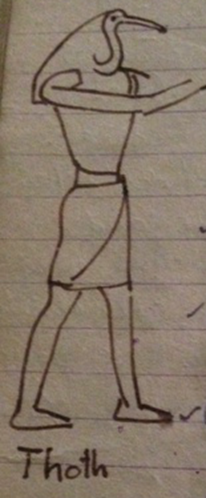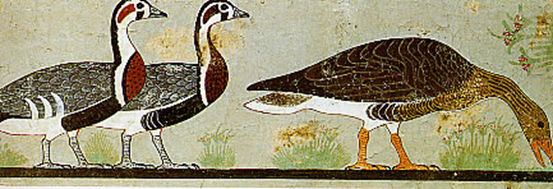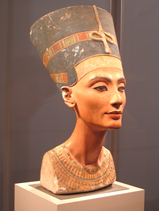Art of Egypt
 The political history Egypt can be divided into four parts. Each of which is
grouped around a city.
The political history Egypt can be divided into four parts. Each of which is
grouped around a city.
- From 3000 to 2000 BC first dynasty to 11 th dynasty ruled at Memphis.
- From 2000 to 950 BC 12th dynasty to 21st dynasty ruled at Thebes
- From 950 BC to 332 BC 22nd dynasty to 31st dynasty reigned at Sais.
- From 305 BC to AD 30 Ptolemy (Greek kings} reigned at Alexandria
Egypt became militant nation and its territories extended southward and eastward up to Euphrates .The thought and religion also changed in the light of the uselessness of the labor that was put by the predecessors and this thought appears in the literature also. The great king conceived the idea of one God whom he called Aton and took for himself the title of Akhenaton that means the spirit of Aton. He also set up a new capital Akhetoon.The military pressure and of the priest made people to believe the idea of one god that was contrary to their tradition. After his death the power again transferred to Thebes.
The art of Egypt concerns with the dead because the wall paintings in Mastabas and Pyramids all belong to dead pharaohs. ‘The book of the Dead is really a collection of the texts recited at the time of death. It contains magic words”. The language was deciphered by the help of Napoleon who invaded Egypt in 1799 and found a slab at Rashid or Rosette and took it to Paris. There the lithographers made copies of it distributed them among the scholars who after great pains could read the language. Thus the Egyptian records became intelligible to the world.
The fields for the expression for the artist were walls, papyrus rolls, and slab of the hard stone, wood and coffin cases. One of the papyrus rolls the longest in the world is in British Museum and measure 163ft in length and 16-% ft. in width. Picture of magic ceremonies, the headings of which are ‘opening of the mouth’, ‘the weighing of the head’ and the ‘journey of the sun god’ and many other pictures are painted on it.
The figures were drawn with little overlapping except in the case of animals where depth was suggested by repeating silhouette. The figures of men and movements were drawn according to the Egyptian law of frontality. The heads and legs in profile and the torso and the eye in front view, actual rather than visual truth appealed the Egyptians’ very strongly.
Some unfinished paintings on the walls show the process of artist’s work. Uneven stones and surface of the walls were covered with the coating of the fine plaster. In the plaster they mixed rice husk and powdered rocks. The artist mixed the pigments with some binding materials as gum and applied them to the dry surface with brushes made of the reeds in flat tones even with no light and shade. They first sketched the picture and then made the incision with the help of chisel to give it a sense of relief. Painting was not used very frequently but painted reliefs. Perhaps the Egyptians scorned the brush inferior to the chisel.

Painting of ‘Gees of Meidum’ is a rare example in Cairo Museum that dates back
to 2900 to 2750 BC.It is naturalistic so far as the movement of the ducks is
concerned but abstract in decoration. In painting the female the flesh is of
yellowish color because the Egyptians women led a more secluded life than the
men whose sunburnt skin is usually painted with dark reddish color. During the
Theban period the painters began to omit relief and painted directly on the
walls with greater freedom of the brush in comparison to chisel.
Some of the outstanding paintings
 Painted sculptured head of the lovely Queen Nefertiti of about 1400 BC is in
British Museum seems modern in its beauty and execution.
Painted sculptured head of the lovely Queen Nefertiti of about 1400 BC is in
British Museum seems modern in its beauty and execution.
Wall decoration in the palaces of noble Khnumhoteb at Benehasan shows the noble killing the fish with the help of a lance. His figure in the center is according to the Egyptian law but in the panels below there is freedom of action shown in the figures. Wave lines are also conventional in the tomb of Nakht at Thebes from 1580 to 1350 BC. The front wall has a false door to provide for the spirit to pass through. On both sides of the door there are square panels in which kneeling figures have been shown offering gifts. In the lower panel there are objects of gifts such as loaf of breads, onions, grapes, meat, lotus and papyrus combined into symmetrical pattern. On the left wall are the large figures of a male and female along with the scenes of agriculture. On the left wall there is banquet scene with six figures seated on a wall near blind musician in which there is a great freedom of pose and variety of movements.
In another scene in a Theban tomb dating from 1580 to 1350 BC.The noble in the center is standing in his boat and driving the birds from papyrus plant. In his right hand he hoards three birds, a hunting cat is in front of king. The two companions are perhaps the wife and daughter who are enjoying lotus, water and the figures are drawn in traditional way but the cats, birds and fishes are of naturalistic.
Specimens of painting on wood have also been found .The wood was covered with linen dipped in glue to furnish a smooth surface for painting. Figures of the dead on the coffins were drawn in bold outlines with flat colors filled in.
Designs are in conventionalized shape particularly with lotus and geometrical forms. During the period from 950 BC to 332 BC the art decayed and the artist only tried to look into the past to revive the bygone glories and the strength of line weakened and designs became complex. The final blow came with the invasion of Alexander the Great in 332 BC.